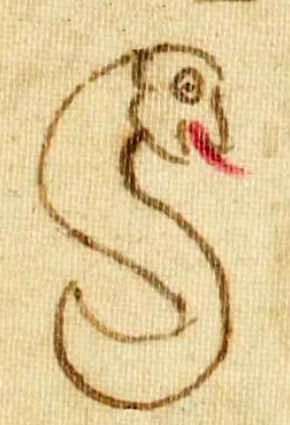coatl (Azca9)
This element of a serpent (coatl) comes from the compound glyph for a personal name (perhaps Calcoatl, see the contextualizing image). The serpent is shown in profile, upright, and facing toward the viewer's right. Its body is curved in an S-shape and is without added color or texturing. Its eye is open, as is its mouth, and its red tongue (not bifurcated) is protruding and curving slightly upward.
Stephanie Wood
The gloss misses the calli element in the compound glyph (if that is what it is). The gloss also adds that this is a "mujer" (woman), when the person is wearing a loincloth and a vertical lock on the top of their head, tied with what seems to be a red leather strap. These are characteristics of priests and warriors (typically male). That said, one woman (Chimalma or Chimalman) was prominent in carrying the accoutrements of divinities in the legendary migration from Aztlan.
Stephanie Wood
cohuatl
coatl
Stephanie Wood
post-1550, possibly from the early seventeenth century
Jeff Haskett-Wood
serpientes, cohuatl, serpents

coa(tl), a snake or serpent, https://nahuatl.wired-humanities.org/content/coatl
Serpiente
Stephanie Wood
The Codex Azcatitlan is also known as the Histoire mexicaine, [Manuscrit] Mexicain 59–64. It is housed in the Bibliothèque Nationale de France, and hosted on line by the World Digital Library and the Library of Congress.
https://www.loc.gov/resource/gdcwdl.wdl_15280/?sp=9&st=image
The Library of Congress is “unaware of any copyright or other restrictions in the World Digital Library Collection.” But please cite Bibliothèque Nationale de France and this Visual Lexicon of Aztec Hieroglyphs.



